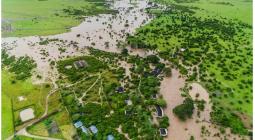Over 120 dead and a million without power after ‘historic’ Hurricane Helene
As the south-east US continues recovery efforts after Hurricane Helene’s devastation, the storm’s death toll keeps climbing, with more than 120 killed across several states.
Joe Biden will visit North Carolina, where the western part of the state has been devastated by flooding, on Wednesday.
In recent days, the president pledged federal assistance to help with recovery efforts – and has said that his administration is giving states “everything we have” to help with their response to the storm.
“It’s not just a catastrophic storm. It’s a historic, history-making storm,” Biden said on Monday morning. He added that “damage from the hurricane stretches across at least 10 states”.
The US homeland security adviser, Liz Sherwood-Randall, said on Monday that there could be as many as 600 deaths, though the figure has not yet been confirmed.
More than 1 million Americans were still without power in the Carolinas and Georgia as of Monday morning.
Helene made landfall last Thursday night in Florida’s Big Bend region as a category 4 hurricane. Even though it weakened to a tropical storm before moving through Georgia, the Carolinas and Tennessee, the storm’s winds, rainfall, storm surge and flooding destroyed entire communities in its path.
On Sunday, North Carolina’s department of public safety said that supplies such as food, water and other needs were arriving in Asheville, a city in Buncombe county that has seen widespread destruction. The state’s national guard was airlifting supplies into counties across western North Carolina, too, officials said.
“This is an unprecedented tragedy that requires an unprecedented response,” Roy Cooper, North Carolina’s governor, said.
Federal Emergency Management Agency officials said Monday that hundreds of roads had been closed across western North Carolina and that shelters were housing more than 1,000 people.
On Sunday on CBS News, the Federal Emergency Management Agency (Fema) administrator, Deanne Criswell, had described the flooding in North Carolina as “historic”, adding: “I don’t know that anybody could be fully prepared for the amount of flooding and landslides that they are experiencing right now.
Over the weekend, more than 500 national guard soldiers helped conduct more than 100 rescue operations in western North Carolina, officials there said. At least 119 North Carolina residents and their pets were rescued.
Cooper has said that the death toll in North Carolina may rise as rescuers and other emergency workers reach other isolated and devastated areas. More than 50 search teams were spread throughout the region in search of stranded people, he said. He has urged residents in western North Carolina to avoid travel, largely so the roads can be clear for emergency crews.
On Monday morning, Cooper appeared on CNN and said that hundreds of roads had been destroyed – and that entire communities had been “wiped off the map”.
“We have to make sure that we get in there and are smart about rebuilding and doing it in a resilient way,” he said. “But right now we’re concentrating on saving lives and getting supplies to people who desperately need them.
“A lot of communities are completely cut off. And by the way, rivers are still rising, so the danger is not over, the flooding is likely not over.”
The University of North Carolina-Asheville said over the weekend that due to the storm’s damage, classes would be suspended until 9 October. The school said that parts of the campus were inaccessible and described “significant tree damage”.
“Cell and internet coverage is nonexistent at this point,” the school also said on Saturday, adding that they were providing security, food, water and comfort to the students who remain on campus.
According to the Associated Press, the storm unleashed the worst flooding in a century in North Carolina.
As of Monday morning, more than 700,000 homes in South Carolina were without power – including more than 500,000 in Georgia and 400,000 in North Carolina, according to poweroutage.us.
In Florida’s Tampa Bay region, the death toll as a result of the hurricane reached nine people on Sunday. All deaths took place in a mandatory evacuation zone, county officials in Pinellas county said.
In Augusta, Georgia, which suffered widespread damage due to the storm, officials are urging residents to limit water use to “essential drinking only for the next 24-48 hours” – a temporary effort to help with the recovery of the area’s water supply.
State officials in South Carolina have announced 25 storm-related deaths in the state so far, according to the Post and Courier, and many residents in South Carolina remain without power.
The National Weather Service office of Greenville-Spartanburg, South Carolina, described the storm over the weekend as the “worst event in our office’s history” in a post on Facebook addressing the residents of western North Carolina and north-east Georgia.
“We are devastated by the horrific flooding and widespread wind damage that was caused by Hurricane Helene across our forecast area,” the post reads. “There are no words to express our sorrow at the loss of life and incredible impacts to property.”
The American Red Cross announced that it had opened or supported more than 140 shelters across the US for nearly 9,400 people driven out of their homes by the storm.
AccuWeather is estimating that Hurricane Helene inflicted between $145bn and $160bn in property damage and economic losses.
Kamala Harris reportedly will visit the areas struck by Helene this week. Her opponent Donald Trump visited Georgia on Monday.
“We’re here today to stand with complete solidarity with the people of Georgia and all those suffering in the terrible aftermath of Hurricane Helene,” the former president said in front of the collapsing brick storefront of Chez What, a furniture and fashion collective in Valdosta. He also turned to spouting falsehoods about the storm and the federal response.



